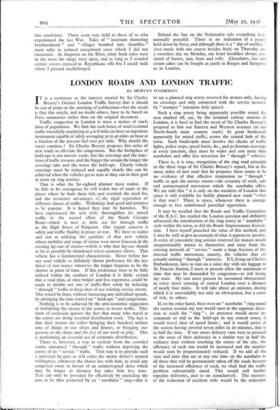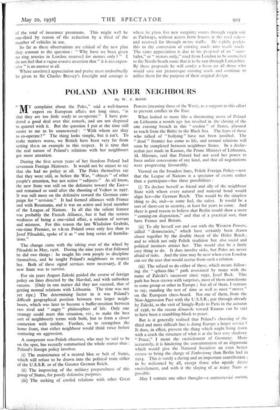LONDON ROADS AND LONDON TRAFFIC
By MERVYN O'GORMAN
IT is a testimony to the interest created by Sir Charles Bressey's Greater London Traffic Survey that it should be out of print on the morning of publication—but the result is that this article, and no doubt others, have to be based on Press summaries rather than on the original document.
Traffic congestion in London is more a matter of roads than of population. We find the rush hours of unidirectional traffic wastefully employing at 4 to 8 miles an hour an ingenious instrument capable of safely averaging 3o to 40 miles an hour at a fraction of the present fuel cost per mile. Why should the waste continue ? Sir Charles Bressey proposes 80o miles of new roads to alleviate the congestions. But the birthplace of hold-ups is not narrow roads, but the crossings and the junc- tions of traffic streams, and the bigger the stream the longer the crossings take and the worse the hold-ups. Clearly vehicle crossings must be reduced and equally clearly this can be achieved when the vehicles get as near as they can to their goal in town on ring arteries.
That is what the far-sighted planner must realise. If he fails to be courageous he will widen lots of roads at the places where he finds them full, and overlook the need for, and the economic advantages of, the rigid separation of different classes of traffic. Widenings look good and promise to be popular. It is hoped they may be harmless. We have experienced the new wide thoroughfare for mixed traffic in the wasted effort of the North Circular Road—which is now as little use for through traffic as the High Street of Kingston. Our urgent concern is safety and traffic fluidity in peace or war. We have to realise and aim at utilising the qualities of that new vehicle whose mobility and range of action were never foreseen in the existing lay-out of streets—which is why that lay-out should as far as possible be abandoned where economy allows. This vehicle has a fundamental characteristic. Never before has any road vehicle so definitely shown preference for the less direct of two routes whenever the longer happens to be the shorter in point of time. If this preference were to be fully utilised within the confines of London it is fairly certain that a road plan, at once -bolder and less expensive, could be made to double our rate of traffic-flow solely by inducing " through " traffic to keep clear of our existing service streets. This would be done, without increasing any individual speeds, by abridging the time wasted on " hold-ups " and congestions.
Nothing is to be achieved by the anti-economic suggestion of forbidding the streets of the centre to motor traffic. That form of exclusion ignores the fact that many who travel at the centre are doing essential distribution work. The fact is that their motors are either bringing their hundred million tons of things to our shops and houses, or bringing our persons to the shops and the foci of our work or play. This is performing an essential act of economic distribution.
There is, however, a way to exclude from the crowded centre unwanted " through " traffic without depriving the centre of its " service " traffic. That way is to provide such a universal by-pass as will enlist the motor driver's natural willingness, whenever the choice lies with him, to avoid any congested route in favour of an uninterrupted drive which may be longer in distance but takes him less time. Tnis can only be provided for effectively by encircling the area to be thus protected by an " autobahn " ring—that is to say a planned ring artery reserved for motors only, having no crossings and only connected with the service network by " trumpet " junctions duly spaced.
Such a ring artery being apparently possible round the area marked off, say, by the terminal railway stations of London, it is hard to find the merit of Sir Charles Bressey's proposal to link our Eastern and Western avenues (or our North-South main country roads) by great boulevards apparently for mixed traffic, across the central hub of the town. Such boulevards must involve the checks of traffic lights, police stops, speed limits, &c., and pedestrian crossings at every junction, they must be wider and cost more than autobahns and offer less attraction for " through " vehicles.
There is, it is true, recognition of the ring road principle in the three rings of Sir Charles Bressey's report, but in the many miles of new road that he proposes there seems to be no evidence of that effective temptation to " through " traffic to quit the service streets—the certainty of swift, safe and uninterrupted movement which the autobahn offers. We are told that " it is only on the outskirts of London that space is still available for boldly planned new roads "—but is that true ? There is space, whenever there is courage enough to face uninformed parochial opposition.
It may be recalled that the Roads and Traffic Committee of the R.A.C. has studied the London question and definitely advocated the introduction of the ring artery in " autobahn " style within the town, as did the Roads Improvement Associa- tion. I have myself preached the value of this method, and it may be well to give an example of what it appears to involve. A series of concentric ring arteries reserved for motors would unquestionably attract to themselves and away from the existing network of " service " roads a large fraction of the internal traffic movement, namely, the vehicles that arc actually making " through " journeys. If I, living on Chelsea Embankment, have to taxi on a rainy day with my luggage to St. Pancras Station, I must at present allow the maximum of time that may be demanded by congestion—or risk losing my train. My taxi must present its unwanted obstructions in every street crossing of central London over a distance of nearly four miles. It will take about 40 minutes, during which it is unavoidably not only an obstruction, but a cause of risk, to others.
If, on the other hand, there were an " autobahn " ring round the station termini my taxi would start in the opposite direc- tion to reach the " ring " ; its presence would never in- commode or add to the hold-ups in any central street, it would travel clear of speed limits ; and it would arrive at the station having covered seven miles in 20 minutes, that is in half the time. If our stores delivery vans were to proceed to the areas of their deliveries in a similar way in half the ordinary time without touching the centre of the city, the efficiency of each van would be increased and the number would soon be proportionately reduced. If we add all the vans and taxis that are at any one time on the autobahn to all those that will be permanently taken off the roads because of the increased efficiency of each, we shall find the traffic problem substantially eased. This would still further expedite deliveries, and so on cumulatively. The measure of the reduction of accident risks would be the reduction of the total of insurance premiums. This might well be one-third by reason of the reduction by a third of the number of vehicles in use.
So far as these observations are critical of the new plan they amount to the question : " Why have we been given no ring arteries in London reserved for motors only ? " I do not feel thai a vague evasive assertion that " it is too expen- sive " is an answer at all.
Where unstinted appreciation and praise must undoubtedly be given to Sir Charles Bressey's foresight and courage is where he plans five new outgoing routes through virgin soil as Parkways, without access from houses at the road side— and reserved for through motor traffic. He r'ghtly prefers this to the conversion of existing roads into trunk roads. The same appreciation is due to his proposal of an " auto- bahn," or " motors only," road from London to be connected to the North-South route that is to be run through Lancashire. By these proposals he will confer a boon on all those who would save our picturesque existing roads and continue to utilise them for the purpose of their original design.



















































 Previous page
Previous page